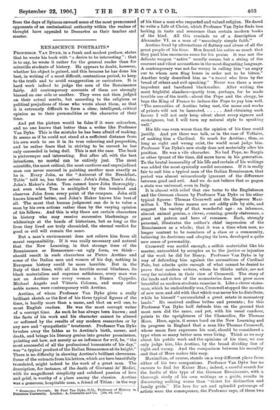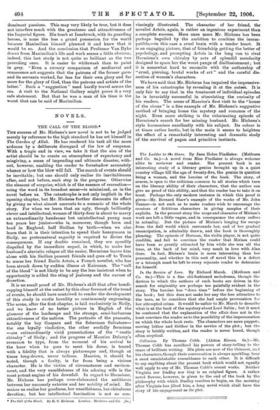RENASCENCE PORTRAITS.* PROFESSOR VAN DYKE, in a frank and modest
preface, states that he wrote his book with "a desire to be interesting": that is to say, he wrote it rather for the general reader than for scientific students of history. He appears to doubt, however, whether his object is gained, and this because he has done his best, in writing of a most difficult, contentious period, to keep to the truth and to avoid exaggeration or caricature. It is hard work indeed to judge the men of the Renaissance fairly. All contemporary accounts of them are strongly biassed on one side or another. They were not then judged on their actual merits, but according to the religious or political prejudices of those who wrote about them, so that it is extremely difficult to form a clear, intelligent, critical opinion as to their personalities or the character of their time.
And yet the picture would be false if it were colourless, and no one knows that better than a writer like Professor
Van Dyke. This is the mistake he has been afraid of making. It seems as if he could not stand at a sufficient distance from his own work to see it in its true colouring and proportion, and he rather fears that in striving to be correct he has only succeeded in being dull. This is not the case. The book is picturesque and interesting. But after all, with the best intentions, no mortal can be entirely just. The most scientific, the most critical, the most cautious and unprejudiced man can never succeed in painting another man exactly as he is. Every John, as the "Autocrat of the Breakfast- Table" told us, has three selves : John's John, Tom's John, John's Maker's John. Tom cannot know John thoroughly ; not even when Tom is multiplied by the hundred and observes John from every point of the compass. John still knows himself better, and John's Maker knows him best of all. The most that human judgment can do is to value a man by his own actions rather than by the varying opinion of his fellows. And this is why there are certain characters in history who may receive successive blackenings or whitenings at the hands of historians, but as long as the lives they lived are truly chronicled, the eternal verdict for good or evil will remain the same.
But a man's environment does not relieve him from all moral responsibility. If it was really necessary and natural that the New Learning, in that strange time of the Renaissance or Renascence—an ugly form, we think— should result in such characters as Pietro Aretino and some of the Italian men and women of his day, nothing in European history could be more horrible. But in the Italy of that time, with all its terrible moral blindness, its black materialism and supreme selfishness, every man was not an Aretino nor every woman a Bianca Cappello. Michael Angelo and Vittoria Colonna, and many other noble names, were contemporary with Aretino.
Aretino, of whom Professor Van Dyke gives a really brilliant sketch as the first of his three typical figures of the time, is hardly more than a name, and that an evil one, to most English readers. He was the most corrupt writer of a corrupt time. As such he has always been known ; and the facts of his work and his character cannot be altered or softened by the results of any modern researches or by any new and " sympathetic " treatment. Professor Van Dyke brushes away the fables as to Aretino's birth, career, and death, and brings his literary genius into greater prominence, pointing out how, not merely as an influence for evil, he, "the most successful of all the professional humanists of his day," was "a typical product of the Italian Renascence at its height." There is no difficulty in showing Aretino's brilliant cleverness. Some of the extracts from his letters, which are here beautifully translated, might indeed be the work of a great man. The description, for instance, of the death of Giovanni de' Medici, with its magnificent simplicity and subdued passion of love and grief, is worthy of a place among the classics. Aretino was a generous, hospitable man, a friend of Titian : in the way
• Renascence Portraits. By Paul Van Dyke, D.D., Professor of History in Princeton University. London : A. Constable and Co. [10s. 6d. not.]
of his time a man who respected and valued religion. He dared to write a Life of Christ, which Professor Van Dyke finds less lacking in taste and reverence than certain modern books of the kind. All this reminds us of a description of Alexander VI. as a man of "amazingly simple faith."
Aretino lived by alternations of flattery and abuse of all the great people of his time. Men feared his satire so much that they paid him enormous sums for his praise. It was not the delicate weapon " satire " usually means, but a string of the coarsest and vilest accusations in the most disgusting language. A contemporary was not far wrong in calling him "an angry cur to whom men fling bones in order not to be bitten." Another truly described him as "a rascal who lives by the bread of others and evil speaking." Never was there a more impudent and barefaced blackmailer. After writing the most frightful slanders—partly true, perhaps, for he made terrible use of the truth—about the Pope and the clergy, he begs the King of France to induce the Pope to pay him well. "The necessities of Aretino being met, the name and works of priests will not be lacerated. And obtaining such favour I will not only keep silent about every signore and monsignore, but I will turn my natural style to speaking well."
His life was even worse than the opinion of his time could justify. And yet there was talk, as in the case of Voltaire, of making him a Cardinal. So much for Aretino ; thus, as long as right and wrong exist, the world must judge him. Professor Van Dyke's new study does not materially alter his position. He was a vile character. No bad Pope, no Borgia or other tyrant of the time, did more harm in his generation. To the brutal immorality of his life and certain of his writings was added the most cynically sordid meanness. If it is really fair to call him a typical man of the Italian Renaissance, that period was almost miraculously ignorant of the difference between good and evil. And we do not believe that so pagan a state was universal, even in Italy.
It is almost with relief that one turns to the Englishman and the German chosen by Professor Van Dyke as his other typical figures : Thomas Cromwell and the Emperor Maxi- milian L The three names are set oddly tide by aide, and suggest the variety pf that wonderful age : an inhuman, almost animal genius, a clever, cunning, greedy statesman, a great art patron and hero of romance. Each, strongly personal, illustrates the author's chief impression of the Renaissance as a whole; that it was a time when men, no longer content to be members of a class or a community, believing its doctrines and obeying its laws, developed a quite new sense of personality.
Cromwell was sordid enough, a selfish materialist like his master, untroubled by scruples as to the justice or injustice of the work he did for Henry. Professor Van Dyke is by way of defending him against the accusations of Cardinal Pole, but admits quite enough of what cannot be denied to prove that modern writers, whom he thinks unfair, are not very far mistaken in their view of Cromwell. The story of the lands and riches of the monasteries does not grow more beautiful as modern students examine it. Like a clever states- man, which he undoubtedly was, Cromwell stopped the mouths of new men and old with that wjiich was never his to distribute, while he himself "accumulated a great estate in monastery lands." He received endless bribes and presents ; for this Professoi Van Dyke half defends him on the ground that most men did the same, and yet, with his usual candour, points to the uprightness of the Chancellor, Sir Thomas More. Here, again, it seems bard on the New Learning and its progress in England that a man like Thomas Cromwell, whose mean face expresses his soul, should be considered a type when so many better men were living. Think as we may about his public work and the opinions of his time, we can only judge him, like Aretino, by the broad dividing line of right and wrong. And the comparison between his morality and that of More makes this easy.
Maximilian, of course, stands on a very different plane from either of his two companions. Professor Van Dyke has no excuses to find for Kaiser Max ; indeed, a careful search for the faults of this type of the German Renaissance, with a thorough study of his own writings as a guide, results in discovering nothing worse than "thirst for distinction and family pride." His love for art and splendid patronage of artists were the consequence, the Professor says, of these two dominant passions. This may very likely be true, but it does not interfere much with the greatness and attractiveness of the Imperial figure. His tomb at Innsbruck, with its guarding heroes, is none the less a grand possession for the world because Maximilian himself planned it and knew that it would be so. And the conclusion that Professor Van Dyke draws from Maximilian's life and work seems a little obvious ; indeed, this last study is not quite so brilliant as the two preceding ones. It is easier to whitewash than to paint in grey. "Even a cursory comparison of mediaeval and renascence art suggests that the patrons of the former gave, and its servants worked, far less for their own glory and far more for the glory of God, than the patrons and artists of the latter." Such a " suggestion " need hardly travel across the sea. A visit to the National Gallery might prove it a very safe statement. But that he was a man of his time is the worst that can be said of Maximilian.







































 Previous page
Previous page